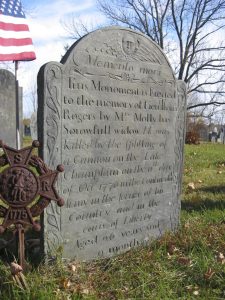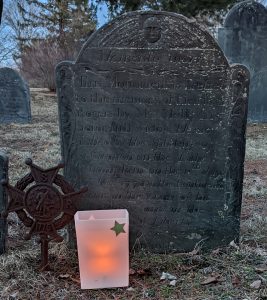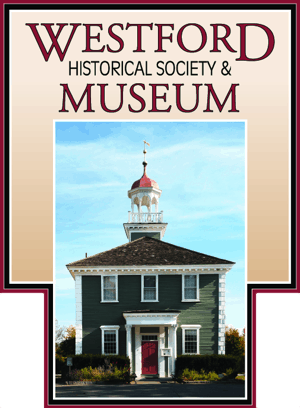By Arnold L. O’Brien (April 2022)
For those who take the Patriots Day Candlelight stroll of Westford’s Fairview Cemetery, one gravesite must be visited for it stands out in its significance, its tragedy and the fact that there is no body under the stone. Following traditional 18th century memorial language there is a lengthy script which begins: “He was killed by the splitting of a cannon….”
Lieutenant Thomas Rogers of Westford awoke to a clear brisk morning in northern New York State on October 11, 1776. His gunboat, the New York, built just a few months earlier, now lay in a bay formed by Valcour Island and the western shore of Lake Champlain. His ship, one of eight, built at Skeensboro (now Whitehall, NY) carried three cannon and formed the center of a 16-ship formation of the Colonial Navy – the largest squadron yet assembled by her nascent nation. They lay in ambush awaiting a much larger, better armed British squadron manned by veteran sailors of the Royal Navy for whom victory was expected and had become the norm. Their commander, Benedict Arnold, had formulated a battle plan based on the arrogance of the British commanders who now sailed rapidly south, driven by that brisk north breeze that awoke Lt. Rogers. As anticipated, the British fleet sailed by Valcour Island to find the Colonial squadron arrayed for battle behind them and now holding a tactical advantage. The British would need to sail into the wind to engage the American fleet. As the British fleet, now in disarray, struggled to draw near the American line, one of their main ships, the schooner Carleton fell into the entrapping formation, suffered heavy damage and was towed away. Soon more British ships with heavy cannon drew near the American formation. The battle that day lasted until 5:00 pm, cannons became hot and as Lt. Rogers serviced one of his 6 -pounders, it exploded, the massive fragments shredding Rogers’ body and wounding his friend and neighbor Sargeant Jonas Holden. In the heat of the battle, Rogers’ body was quickly thrown overboard to keep the decks clear. And that night facing overwhelming odds, the American fleet, under cover of darkness and fog, sailed silently and in single file through the British line and headed south to Fort Ticonderoga. The dead, left behind, were embraced by the waters of Valcour Bay.
 Over a month later Sargent Jonas Holden arrived home in Westford and reported the fateful news to Molly Rogers. Six months pregnant and deeply bereft, the widow Rogers erected the stone with a most unusual inscription.
Over a month later Sargent Jonas Holden arrived home in Westford and reported the fateful news to Molly Rogers. Six months pregnant and deeply bereft, the widow Rogers erected the stone with a most unusual inscription.
He was killed by the splitting of a
Cannon on the Lake Champlain
On the 11th day of Oct’ 1776 in the
Continental Army in the service of his
Country and in the cause of
Liberty – Aged 26 years and 9 months.
In the ensuing years Molly Rogers lost her child to illness and left Westford to marry Wm. Munroe, the owner of the Lexington Tavern. Jonas Holden continued to serve the American cause and four years later was at the concluding battle of Yorktown. Following the war, he left Westford and died in Vermont, sixty years after joining “the cause”. Lt. Rogers’ boat escaped to Ticonderoga but was burned the following year to prevent it falling into the hands of the advancing British Army. Its sister ship, the Philadelphia, sank in Valcour Bay in the late afternoon of the battle. It was raised in the 1930’s and can be seen today in the Smithsonian.
It is doubtful that anyone living at that time could have foreseen the importance of the battle of Valcour Island to the American cause. Technically a loss for the Colonial Navy, the action halted the British advance from the north in 1776. British forces returned, however, sweeping down
in 1777, taking Ticonderoga, then moving south along the Hudson River where they were defeated at Saratoga. The additional year had given American forces time to build a strong army which captured the entire British invasion force and this changed everything. New England was not severed from New York and the other colonies as the British had intended. The French, sensing victory, sent land and sea forces to support the independence movement. A combined French-American army coordinating with the French Navy captured the last British Army at Yorktown in 1781. Did the Valcour Island battle make all this possible? There are historians today who think the answer is Yes!
Molly Rogers’ stone, erected in her grief, connects Westford to that significant event.
A,L. O’Brien (2022)
 Join us while the sun sets for our first-ever Patriots Day (April 19th) Candlelight Tribute in the Old Division of Fairview Cemetery. *TUESDAY APRIL 19th 6:30-8pm In this unique self-guided stroll, you can access the service records of Westford’s Revolutionary War Patriots on your phone or tablet. There will be colonial interpreters to answer your questions stationed throughout the illuminated cemetery. Enter through Tadmuck Rd, Fairview Cemetery entrance.
Join us while the sun sets for our first-ever Patriots Day (April 19th) Candlelight Tribute in the Old Division of Fairview Cemetery. *TUESDAY APRIL 19th 6:30-8pm In this unique self-guided stroll, you can access the service records of Westford’s Revolutionary War Patriots on your phone or tablet. There will be colonial interpreters to answer your questions stationed throughout the illuminated cemetery. Enter through Tadmuck Rd, Fairview Cemetery entrance.
